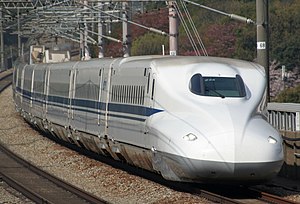Sanyo Shinkansen
| San'yō Shinkansen | |||
|---|---|---|---|

|
|||
| Overview | |||
| Native name | 山陽新幹線 | ||
| Type | Shinkansen | ||
| Locale | Japan | ||
| Termini |
Shin-Ōsaka Hakata |
||
| Stations | 19 | ||
| Daily ridership | 110,004 passengers per km per day (FY2014) | ||
| Operation | |||
| Opened | 15 March 1972 | ||
| Owner | JR West | ||
| Operator(s) |
JR Central JR Kyushu JR West |
||
| Depot(s) | Osaka, Okayama, Hiroshima, Hakata | ||
| Rolling stock | 500 series 700 series N700 series |
||
| Technical | |||
| Line length | 553.7 kilometres (344.1 mi) | ||
| Track gauge | 1,435 mm (4 ft 8 1⁄2 in) | ||
| Electrification | 25 kV AC, 60 Hz, overhead catenary | ||
| Operating speed | 300 km/h (185 mph) | ||
|
|||
The San'yō Shinkansen (山陽新幹線 San'yō Shinkansen?) is a line of the Japanese Shinkansen high-speed rail network, connecting Shin-Osaka in Osaka with Hakata Station in Fukuoka, the two largest cities in western Japan. Operated by the West Japan Railway Company (JR West), it is a westward continuation of the Tōkaidō Shinkansen and also serves other major cities in between on Honshu and Kyushu islands such as Kobe, Himeji, Okayama, Hiroshima, and Kitakyushu. The Kyushu Shinkansen continues south of Hakata to Kagoshima. The San'yō Shinkansen connects Hakata with Osaka in two-and-a-half hours, with trains operating at a maximum operating speed of 300 km/h (185 mph), with the following exceptions: east-bound trains have a maximum speed between Himeji and Shin-Kobe of 275 km/h and west-bound trains have a maximum limit of 285 km/h from Shin-Ōsaka to Shin-Kobe and 275 km/h from Shin-Kobe to Nishi-Akashi. Some Nozomi trains operate continuously on San'yō and Tōkaidō Shinkansen lines, connecting Tokyo and Hakata in five hours.
Train sets operating on the line include:
All stations on the San'yō Shinkansen are owned and operated by JR West, with the exception of Shin-Osaka which is run by Central Japan Railway Company (JR central). Kodama trains stop at all stations; other services have varying stopping patterns. All trains stop at Shin-Osaka, Shin-Kobe, Okayama, Hiroshima, Kokura, and Hakata.
...
Wikipedia

